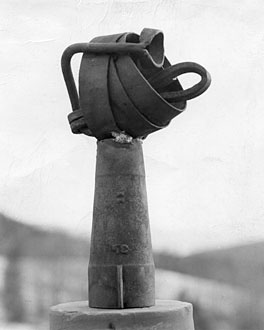
|
ABOVE: David Smith, Agricola Head, 1933. Iron and steel, painted, on painted wood base, 18 7/8 x 10 x 7 1/4 inches; base: 2 7/8 x 25.4 x 18.4 inches). The Estate of David Smith, Courtesy of Museo Nacional Centro de Arte Reina Sofía, Madrid. Photo by David Smith © 2006 The Estate of David Smith/Licensed by VAGA, New York.
|
|
|






David Smith: A Centennial opens with Smith’s first explorations into sculpture, made shortly after an extended trip to the Virgin Islands in 1932. Smith had trained as a painter, enrolling at the Art Students League in 1927, where he studied with John Sloan and Jan Matulka. Under Matulka’s tutelage, he began to attach objects to the surface of his paintings, and his first bona fide sculptures grew directly out of this practice, the canvas becoming a base for constructions of wood, wire, and coral. Matulka also exposed Smith to European metal sculpture through reproductions in magazines such as Cahiers d’art. Smith, who had worked as a welder on an assembly line at the age of 19, felt he intuitively understood these sculptures, later claiming, “Then the world kind of opened for me. . . . I realized that I too knew how to handle this material.” In 1933, when Smith turned to welding in his sculptural practice, he began by making a series of heads, following the example of many Cubist works on this theme. Agricola Head, shown above, is a typical example, and is evidence of the high level of formal sophistication and innovation that appeared in Smith’s work from the very beginning of his career.
Throughout the 1930s, Smith continued to grapple with his European influences. Like the Cubists and Surrealists, he made relatively small-scale works during this period, often based on well-established themes: reclining figures, musicians, dancers, bathers, interiors. More significantly, during these first years of his work with sculpture, Smith sought to define a systematic style of metalworking that could incorporate the open structures first explored in Picasso’s constructions. Disregarding the importance of central mass, a formal concept around which sculptures had historically been organized, Smith instead defined a hollow space at the heart of his works through a network of lines and planes. In this way he offered a sculptural translation of the flat forms of Synthetic Cubism. Notably, Smith often painted these works, and he later summarized this ongoing dialogue between painting and sculpture by claiming, “In my own case, I don’t know whether I make some pieces as painted sculpture or paintings in form.”
|